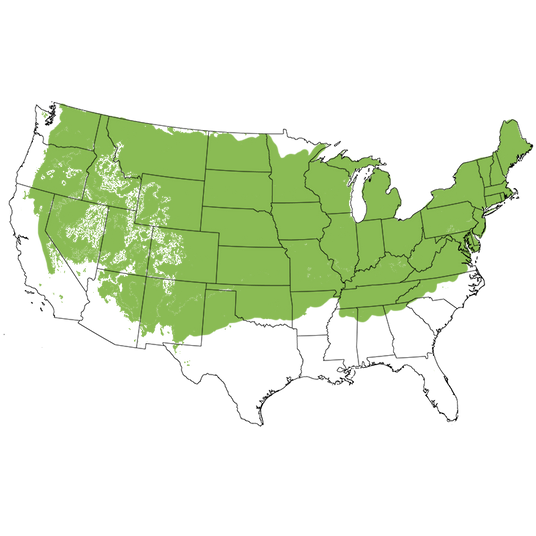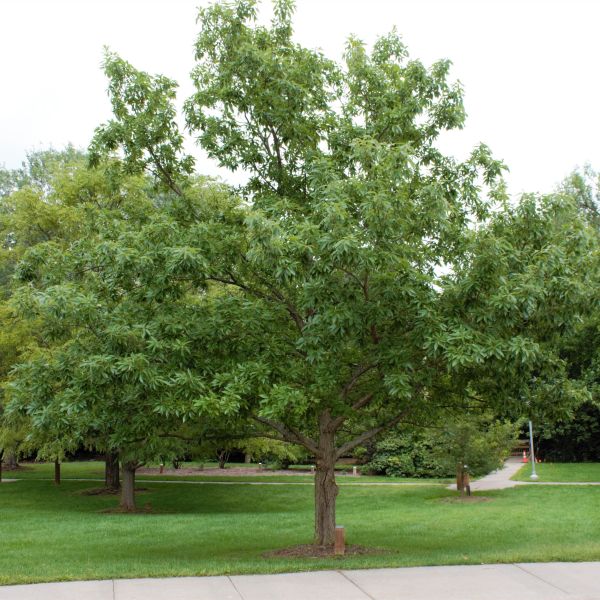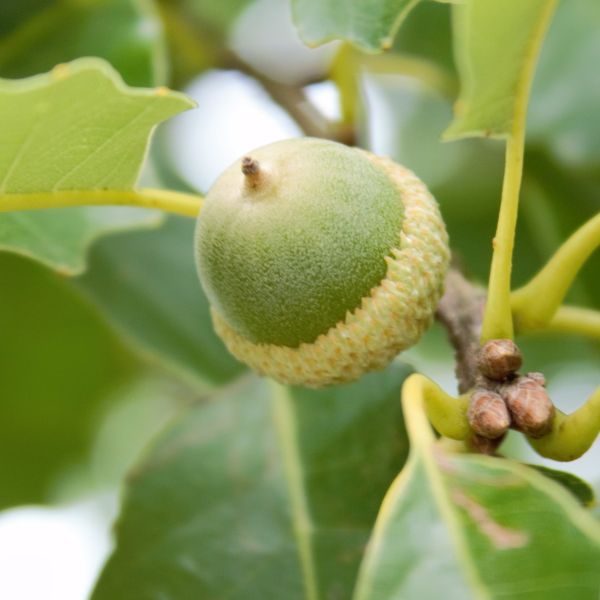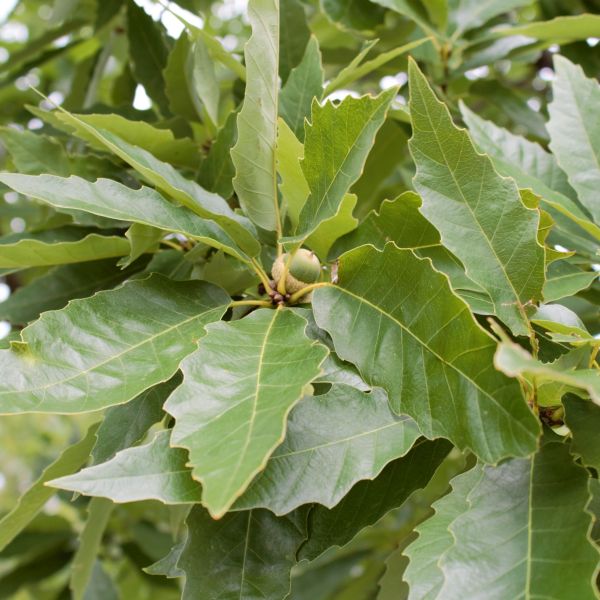Chinkapin Oak Tree
Quercus muehlenbergii
Plant Sentry™
Plant Sentry™

Plant Sentry™ Protected
Your order is protected by our compliance system that:
- Prevents restricted plants from shipping to your state
- Ensures plants meet your state's agricultural requirements
- Protects gardens from invasive pests and diseases
Delivery and Shipping
Delivery and Shipping
Delivery and Shipping
Fast, Safe Plant Delivery
Ships in 3-4 business days • Tracking provided • Weather protected
| Under $50 | $9.99 |
| $50 - $99.99 | $14.99 |
| $100 - $149.99 | $16.99 |
| $150 - $198.99 | $24.99 |
| $199+ | FREE |
✓ Zone-specific timing • ✓ Professional packaging • ✓ Health guarantee
Understanding Plant Options
Nature Hills offers plants in two main formats:
- Container Plants: Grown in pots with soil, sized by container volume and plant age
- Bare Root Plants: Dormant plants without soil, sized by height measurements
Container Plant Sizes
Container sizes indicate plant age and growing capacity rather than liquid volume equivalents. Our containers follow industry-standard nursery "trade gallon" specifications, which differ from standard liquid gallon measurements.
Young Plants (6 months to 18 months old)
| Container Size | Actual Volume | Metric Equivalent |
|---|---|---|
| 2" x 2" x 3" | 0.18 - 0.21 dry quarts | 0.20 - 0.23 dry liters |
| 4" Container | 0.31 - 0.87 dry quarts | 0.35 - 0.96 dry liters |
| 4.5" Container | 0.65 dry quarts | 0.72 dry liters |
| 6" Container | 1.4 dry quarts | 1.59 dry liters |
| 1 Quart | 1 dry quart | 1.1 dry liters |
| 5.5" Container | 1.89 dry quarts | 2.08 dry liters |
Established Plants (18 months to 2.5 years old)
| Container Size | Actual Volume | Metric Equivalent |
|---|---|---|
| 2 Quart | 2 dry quarts | 2.2 dry liters |
| #1 Container | 2.26 - 3.73 dry quarts | 2.49 - 4.11 dry liters |
| 5" x 5" x 12" | 3.5 - 4.3 dry quarts | 3.85 - 4.74 dry liters |
Mature Plants (2-4 years old)
| Container Size | Actual Volume | Metric Equivalent |
|---|---|---|
| #2 Container | 1.19 - 1.76 dry gallons | 5.24 - 7.75 dry liters |
| #3 Container | 2.15 - 2.76 dry gallons | 8.14 - 12.16 dry liters |
Large Plants (3-5 years old)
| Container Size | Actual Volume | Metric Equivalent |
|---|---|---|
| #5 Container | 2.92 - 4.62 dry gallons | 12.86 - 20.35 dry liters |
| #6 Container | 5.25 - 6.01 dry gallons | 23.12 - 26.42 dry liters |
| #7 Container | 5.98 - 6.53 dry gallons | 26.34 - 28.76 dry liters |
Bare Root Plants
Bare root plants are sold by height from the root system to the top of the plant. Plants may exceed minimum height requirements.
Common Sizes:
- Trees: 1 foot, 2 feet, 3 feet, 4 feet, 5 feet, 6 feet
- Shrubs & Perennials: 1 foot, 18 inches, 2 feet
Important Notes
Container Volume Specifications
- Trade Gallon Standard: Our containers follow industry-standard "trade gallon" specifications established by the American National Standards Institute (ANSI Z60.1) for nursery stock
- Volume Variations: Actual soil volume may vary due to plant root systems and growing medium settlement
- Age Indicators: Container size primarily indicates plant age and maturity rather than liquid volume equivalents
Growing Conditions
- Plant size can vary based on variety and growing conditions
- Container size helps indicate plant maturity and establishment level
- Larger containers generally mean more established root systems and faster landscape establishment
Seasonal Availability
- Bare root plants are available seasonally when dormant
- Container plants are available throughout the growing season
- Specific varieties may have limited availability in certain sizes
Questions?
For questions about specific plant sizes or availability, please contact our plant experts who can help you choose the right size for your landscape needs.

Plant Sentry™ Protected
Your order is protected by our compliance system that:
- Prevents restricted plants from shipping to your state
- Ensures plants meet your state's agricultural requirements
- Protects gardens from invasive pests and diseases
Plant Profile & Growing Essentials
Cold hardy, Native, Fall Color/Interest, Clay Tolerant, Drought resistant, Hedge/Screen, and Non-invasive
Specifications
Specifications
-
Botanical Name
-
Height
-
Width
-
Growing Zones
-
Sunlight
-
Growth RateSlow
-
Leaf Color
-
Fall Color
-
NativeYes
-
Pollinator FriendlyYes
-
Bloom PeriodLate Spring
-
Does Not Ship ToAK, HI, ID, MT, OR
Planting & Care Instructions
Planting & Care Instructions

Growing Zones 4-7
Beautiful Wildlife Tree Chinkapin Oak
These days, more and more American property owners are seeking out the beauty of our native trees. This valuable native Oak is a wonderful way to support your local ecosystem.
The Chinkapin Oak (Quercus muehlenbergii) is a fantastic tree to add for attracting and feeding wildlife. Keep your eyes peeled for grouse, turkey, quail and small creatures like chipmunks and squirrels. Even deer adore the sweet acorns of the Chinkapin!
Young trees develop a straight trunk with wonderfully textured bark that draws kids to pat and poke at it. You'll love watching them play underneath its sturdy branches!
Chinkapin is a member of the White Oak group. Some people spell it Chinquapin Oak and you'll hear it called Yellow Oak. Either way—it has those showy, shiny leaves that you love all season long.
Long and leathery, with ornamental wavy edges, Chinkapin's dark green leaves cast a delightfully refreshing shade over you and your family and friends.
Plant on the south or southwest of your home to add property value and eventually reduce your cooling bills. Please give this magnificent tree a large space to grace with its full mature height and spread.
As the nights grow colder, you'll be treated by a rustic display of harvest colors. Sophisticated golden yellow-orange and warm russet-brown more than hold their own as a desirable autumn display.
Once the tree reaches maturity, it starts producing dark brown acorns to the delight of neighborhood squirrels and more. Chinkapin produces this nutritious mast on a periodic cycle.
Plant several Chinkapins if you have the space, and layer in other wildlife plants for a bio-diverse food forest. Nature Hills is so pleased to bring you expertly grown native plants that bring beauty and support animals of all shapes and sizes.
How to Use Chinkapin Oak Tree in the Landscape
This is a magnificent legacy tree native to North America. You'll feel very proud of your superior choice for a responsible shade tree. Use a single tree to develop into a magnificent specimen. You'll be passing on a tremendous gift to future generations of tree-lovers.
If you have room, several Chinkapins make an incredible grove. Vary the spacing and scatter them in loose "drifts" for a natural look.
You'll want to create a comfortable experience near your trees. Plan a fire pit nearby, or tuck classic Adirondack chairs in their shade.
On a corporate campus, these trees can add a stately look. Try them with other Oaks, Beeches and Maples for an enthralling display, especially as autumn rolls around.
- Stunning, Wide-Spreading Crown
- Unique Variety of White Oak
- Wildlife Love The Sweet Acorns
- Robust Leaves Feature Smooth, Shallow-Lobed Margins
- Warm-Toned Fall Colors of Orange, Yellow & Russet Brown
- Textured Bark Appeals to Kids
- Naturally Found in Limestone Outcroppings
- Valuable Timber Used for Furniture & Railroad Ties
- Versatile Across Much of the United States
#ProPlantTips for Care
Plant in full sun. Chinkapin Oak needs at least six hours of direct sunlight, and would happily bask in full-blast rays all day, every day.
Rugged Chinkapin Oak adapts to nearly any soil. However, the soil must drain quickly after a rainfall. If you have standing water periodically on your planting site, consider the Swamp White Oak.
Like several Oaks, Chinkapin is best transplanted while young. Add a packet of Nature Hills Root Booster while planting, following the directions on the label. It includes mycorrhizae fungi which helps plants to initiate the tiny feeder roots, and increases their access to water and micro-nutrients.
We do recommend supplying supplemental water for best results. Provide a medium amount of water on a regular basis, especially during the first year. Mulch over the roots, but pull it back away from the trunk.
If needed, prune to correct shape in late winter. Help young trees achieve their potential with thoughtful pruning. Remove crossing branches, and clean up the interior of the canopy.
- Full Sun
- Tolerates Alkaline Soils & Many Other Well-Drained Soil Conditions
- Moderate to Low Moisture
- Prune When Dormant
- Long-Lived Hardy Tree
Even as a young tree, Chinkapin Oak elevates the tone of your space. Over time, you'll be thrilled with its charming impact and so will the local wildlife. Order now!














